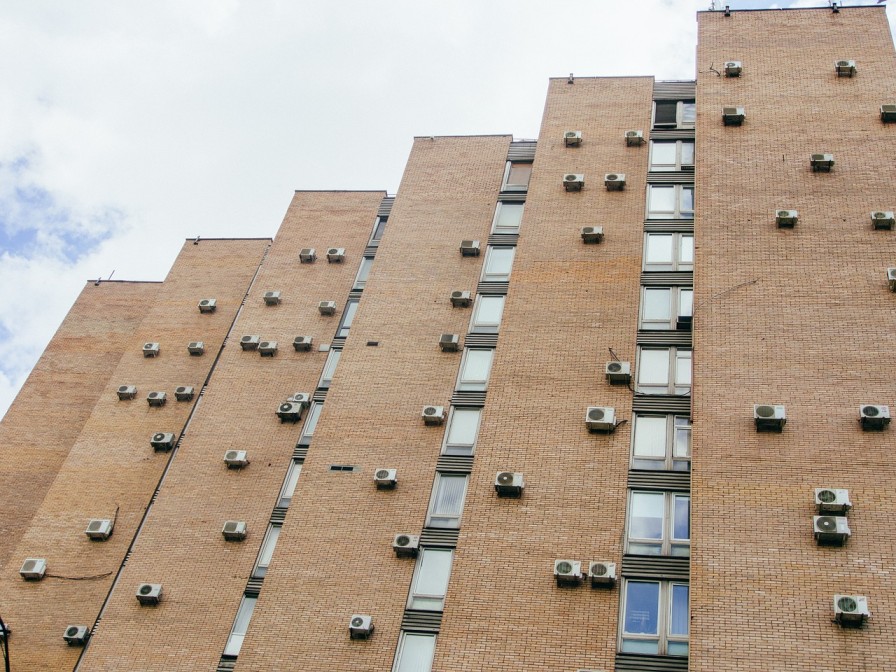A Single AC Could Power 25 Ceiling Fans: How to Make Your Home Cool & Eco-Friendly
Serving a pre-emptive strike on the colossal amount of carbon emissions let out by the future demand for air conditioners, here are a few ways in which we could look at building sustainably cool and eco-friendly homes.

“Taking thought for the morrow is a waste of time, I believe, because all we can do to prepare rightly for tomorrow is to do the right things today.” – Wendell Berry (farmer, author, poet) in A Narrative for the Future.
Are you reading this article in an air conditioned room? Do you spend significant amounts of time a day with the air conditioning running? If yes, then consider this: that sleek looking AC humming silently, efficiently in the background, without generating any obvious pollution, consumes as much power as 25 ceiling fans; that’s about 10 lower-middle class homes that could be kept cool if this one AC was turned off. Not only is it an energy-guzzler it’s also a primary cause of climate collapse now. If used even for just eight hours a day for eight months a year, it generates enough climate pollution that negates the benefit of 115 trees, analysis by Fairconditioning Foundation.
India is yet to build 70 per cent of the buildings that will come into existence in 2030. If we do nothing and allow these buildings to be built through a real-estate economy that loves more-of-the-same, the number of air conditioners installed in India’s homes will skyrocket from about 50 million ACs today to 225 million ACs in 2035, as cited by Fairconditioning & Chaturvedi V, Sharma M, Chattopadhyay S, and Purohit P. HFC emission scenarios for India and CEEW report. The perilous levels of climate pollution generated through their use of electricity and emission of super greenhouse gases, which are much more powerful than carbon dioxide, are a growing cause for concern.
The Indian regulatory authorities and the market responses to this ballooning AC demand and associated climate breakdown have been to administer end-of-pipe solutions without diagnosing the root cause of unsustainable construction in India. It is a lot like administering medicines without diagnosing patients first.

These market-based approaches leave the undergird, on which this inexorable rise of ACs is based, completely intact. Certifications and labelling systems have proven inadequate, and even after 18 years, only 4 per cent of India’s built-space is green and only 5 per cent of its architects/building engineering consultants are certified green building professionals. At this rate, the current green building paradigm (which forms the most structured mechanism for incentivising, mitigating, cooling-related climate impacts in India), appliance standards and labelling schemes (such as energy-star rating systems) will prove wholly inadequate as a means to keep our earth habitable for life as we know it.
Instead of searching for a single big solution to this problem, we must finally recognise that such a pervasive and complex problem will require a pluriverse (not a ‘uni’verse) of responses. For this systemic transformation to avoid the hubris of dominance of nature, it must espouse a liberatory discourse that avoids further concentration of power in a few hands. It is reasonable to think that those responses operating at a local or meso-scale level — which foster autonomy, local economic resilience, decentralisation of ownership of the problem and its contextualised response with a deeply felt empathy by specific communities — will be the ones to succeed.
One powerful theme for the regeneration of our collective social imagination could be the internalising of sustainable cooling into all parts of the building’s economy imbibed as a default rather than a value addition.
For academic institutions that influence the value system of future architects, this means establishing parity between climate safety aspects of building designs (of which sustainable cooling is a predominant aspect) and other imperatives such as structural and fire safety.
And for practicing architects, this would mean building enough capacity and skill so that all licensed architects can offer sustainable cooling-related design services to the building industry as a non-negotiable value. The usual defense offered by a status-quo loving architecture enterprise is that we do have ‘green buildings’ in our portfolios. Sure they do, but these are anomalies; they make it to the cover of the brochure (referred to as event architecture) – flip it open and it’s more of the same building indistinguishable from a building in Dubai or Singapore.
The underlying hypothesis here is that if sustainably cooled buildings are offered as a value-addition for a higher fee, then the client (builder) can choose to reject and opt for status-quo designs. This defaulting of sustainable cooling at academic and professional practice levels can lead to integration of passive designs, which inhibit the sun’s heat from entering the building, or sustainable cooling systems in an invisible manner. We will then see a rise of buildings that are decidedly alien to the established norms.
Another compelling regenerative theme would be the idea of beginning-of-pipe solutions instead of end-of-pipe solutions. We must work proactively, upstream at the ‘beginning of the pipe’, and not reactively at the ‘end of the pipe’, expending vast resources repairing the technological dysfunctions of buildings designed by poorly trained professionals.
This translates to working with immense momentum and perhaps the largest share of sustainable-cooling related monetary and non-monetary resources being allocated for overhauling of current architecture curricula. This beginning-of-pipe approach must deconstruct the issue where the hegemonic idea of air conditioning as a default practice is born. The reverberations of the failure to address these issues in architecture academia and lacunae in the professional ethics of architecture practice, will be felt across our historic arc of human existence if we do nothing about it now.
(Edited by Yoshita Rao)
If you found our stories insightful, informative, or even just enjoyable, we invite you to consider making a voluntary payment to support the work we do at The Better India. Your contribution helps us continue producing quality content that educates, inspires, and drives positive change.
Choose one of the payment options below for your contribution-
By paying for the stories you value, you directly contribute to sustaining our efforts focused on making a difference in the world. Together, let's ensure that impactful stories continue to be told and shared, enriching lives and communities alike.
Thank you for your support. Here are some frequently asked questions you might find helpful to know why you are contributing?


This story made me
-
97
-
121
-
89
-
167














